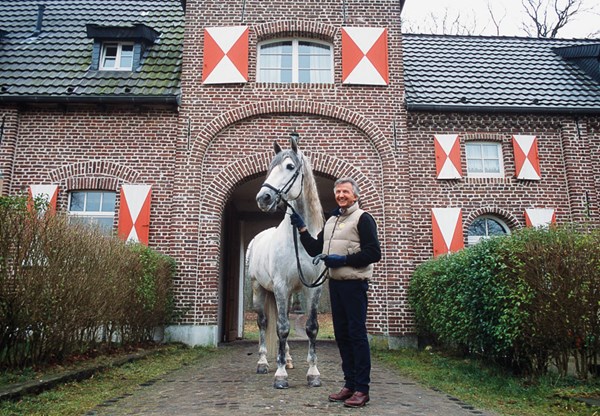For riding at First Level, Patriot is showing a nice free and forward ridden trot movement. His inside hind leg is stepping well under the rider’s weight and his front leg shows a nice free movement and lift off the ground. He looks like the ideal mount for someone who wants to learn and advance in dressage.

Madison is sitting balanced, and I like her long and supple leg position. In her upper body she has a natural supple posture that is only disturbed by her habit of looking down. She should always look ahead to where she is riding, not down onto her hands. Our body automatically activates all the muscles to ride into the direction of our view, so looking straight ahead helps to ride straight forward, too.
Looking at her leg position, I notice that she has pushed her mobile phone down into her riding boot. This may be a handy place, but (I may be a bit old fashioned having grown up in pre-smartphone times) in my opinion the focus during riding belongs to the horse. Conversations can wait and messages can be read later. Horses have good ears and are quick learners. If a horse understands that after the ring of the phone his rider will stop and walk on a long rein, then a similar ringing tone can cause him to stop in unwanted situations as well.
Dressage needs concentration, and if we look to the aids as our means of communication, then riding is a dialog, a conversation with the horse. Interrupting a conversation can be rude, and we may not get to the depth of understanding we just achieved after a phone call. So unless you are waiting for a really important call, leave the phone in your locker and use the time of riding to talk to your horse (who is your friend, too).
The general harmony of this photo is disturbed a bit by Patriot tilting his head. The horse’s ears should be the same height, and the rider should see the corner of the horse’s eye and nose. In this photo, Madison seems to see more eye than nose of her horse, and this is caused by Patriot tilting in the neck. This is a typical mistake that happens when a rider uses too much inside rein aid and does not support and control her horse’s outside shoulder enough with her corresponding aids.
The line of Madison’s arm to Patriot’s mouth is straight, but his slightly open mouth gives the impression that he is a bit too heavy on the rein.
Tip: To become more aware of your horse’s straightness, here is an exercise that is helpful: Ride on the second track and make sure that after every corner you feel your horse straightening. Keep in mind that correct flexion should be only in the horse’s poll with his neck staying between his shoulders.
It helps some people to imagine that the horse’s shoulders are like walls and his head should not scrape the walls as he travels.
Madison should be able to feel, after every corner, that Patriot is straight and stays straight on the inside track even while she is releasing the reins for one or two strides.
Überstreichen is the German word that describes what’s happening. This is a good test to confirm that she is not using too much inside rein. Patriot will have to carry himself in this situation and their balance will improve. I am sure that with a nice natural forward movement, Madison’s ability to ride Patriot will improve.
Susanne von Dietze is a leader in equestrian biomechanics. A physiotherapist, licensed Trainer A instructor and judge for dressage and show jumping, she gives lectures and seminars throughout the world, including at the prestigious German Riding Academy in Warendorf. She is a native of Germany and now lives with her husband and three children in Israel, where she competes at the international level. She is the author of two books on the biomechanics of riding: Balance in Movement and Rider and Horse, Back to Back. Find her books at HorseBooksEtc.com.











